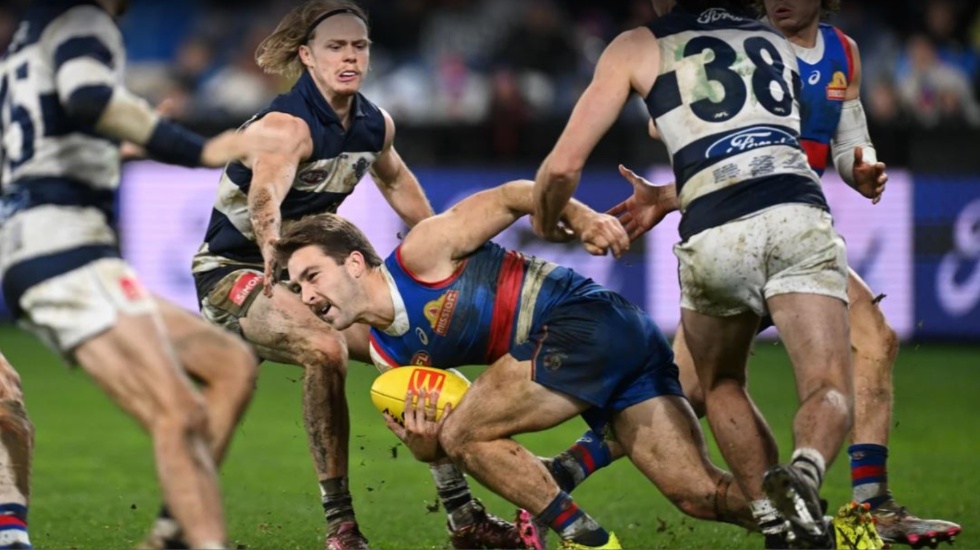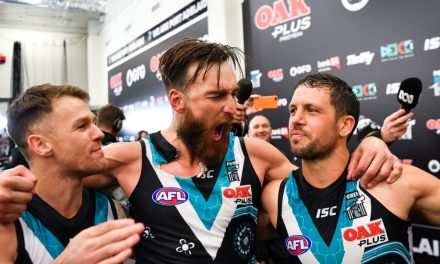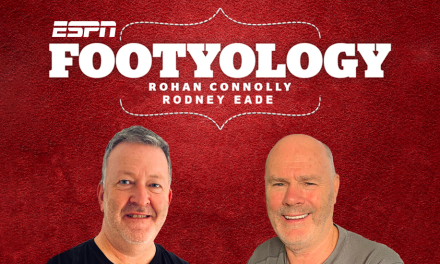Western Bulldog Rhylee West tries to break clear of a cluster of Cats in difficult conditions at Geelong. Photo: AFL MEDIA
Nothing better illustrates a generational divide in AFL football than the concept of playing in inclement weather and difficult conditions.
And perhaps not surprisingly, given we’re in the depths of winter, there’s been plenty of food for thought to that end in recent weeks.
On the one hand, you have the old school. Not just the legion of former players turned commentators, but the fans who grew up with wet days, wet grounds and plenty of mud simply as par for the course.
On the other, the players and maybe even fans of today, relatively spoiled for comfort by far better surfaces and grounds-keeping, not to mention a stadium with a roof. And the mindsets of both sometimes appear dramatically different.
Last Saturday night’s Geelong-Western Bulldogs game at GMHBA Stadium was certainly wet. After a VFL curtain-raiser played before it, there was even, heaven forbid, a little mud. But the strength of the reactions to that surprised a few of us oldies.
Geelong veteran Mitch Duncan has seen plenty of football. But he was far from happy about the conditions when asked about them earlier this week.
“It was probably the worst I’ve ever played on at an AFL game,” he said. “Which I think is a little bit disappointing; but we won’t delve into it too much. I’m sure they’ll be busy in the next couple of weeks to try to get it ready to go for the Adelaide game (in Round 21).”
Western Bulldogs pair Jamarra Ugle-Hagan and Ed Richards were similarly unimpressed when interviewed post-game.
“It was (like) running out in a paddock with how muddy it was, it was pretty dangerous out there – obviously just had to keep your feet, but it was really wet out there,” Ugle-Hagan said.
“I wouldn’t have thought an AFL ground would be like this, but it happens, I guess,” said Richards. “I was talking to Tommy Stewart in the middle of the game, and I was like: ‘You guys have got to give this ground a bit of a breather; it just looks like it’s been absolutely thrashed’.”
I’m sure I’m not the only football fan in their 50s or older who raised eyebrows at those remarks. It’s not as though the game had been reduced to a completely dour slogfest. There were 20 goals kicked in total, and plenty of coherent passages of play.
Most people of my vintage will recall some of the gluepots that prevailed in mid-winter during the 1970s and ‘80s. Some of us can even recall specific seasons (1977 and 1989 are the years usually rattled off) when for months, they were pretty much the weekly standard.
Compare, say, the centre squares of Moorabbin or South Melbourne’s old Lake Oval circa 1977, with what GMHBA Stadium was like last Saturday night. Think of the state of North Melbourne’s Arden Street that famous afternoon in 1977 when Malcolm Blight kicked out of bounds after the siren and the Roos lost to the Hawks.
PLEASE HELP US CONTINUE TO THRIVE BY BECOMING AN OFFICIAL FOOTYOLOGY PATRON. JUST CLICK THIS LINK.
Now those were difficult conditions. You’d be hard pressed to even call what was at the Cattery proper mud in comparison.
Not that I’m arguing that the views of today’s players are wrong, or soft, or whatever angry old men are supposed to think, mind you. We have a fully professional, multi-million dollar professional sport going on. Players are entitled to expect the very best resources where humanly possible.
But was Geelong last weekend really “dangerous” as such? The turf wasn’t so chopped up that players were sinking, or getting stuck and perhaps risking serious injury. And it’s here where historical context is handy.
Dangerous, of course with the benefit of hindsight, is the mud which covered the MCG centre corridor in 1989 for months.
They were conditions which, during the famous Victoria-South Australia state of origin game in front of 91,960, saw Hawthorn’s Andy Collins, playing for Victoria, drag down his Hawk teammate, South Australian Tony Hall, in a tackle from behind.
Wedged in the mud, Hall was seriously injured, missed a year-and-a-half of football, and missed out on playing in Hawthorn’s 1989 flag.
Dangerous was the pot-holed, sandy and loose surface of Waverley in the pre-season of 1993, one which saw Carlton’s Luke O’Sullivan rupture an ACL, a career-ruining injury which resulted in him years later successfully sueing the league and his old club for damages.
That, however, was a clear case of negligence both in terms of the ground preparation, then the lack of oversight in allowing games to proceed on a surface obviously unfit for play. Could that really be said last Saturday night, even after a curtain-raiser?
I’m all for decent health and safety regulations, but there has to be a balance drawn between a certain level of vigilance and the recognition that we are still playing a (largely) outdoors sport in the middle of winter.
And some elements of that simply can’t be controlled, be they rain, mud, or, as was the case one infamous night in Canberra in 2019 when the Giants played Hawthorn, snow.
The roof at Marvel Stadium and the relative bowling green-like surfaces on AFL venues now mean most players will rarely have to deal with genuine adversity when it comes to ground conditions.
It’s clearly more of a shock to a lot of players now on the few occasions they do. Which is fair enough. I’m not saying they need to toughen up. But they do perhaps occasionally just need to chalk things up as a learning experience and simply get on with their business.
This article first appeared at ESPN.










